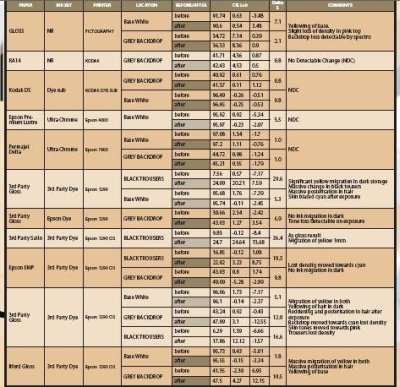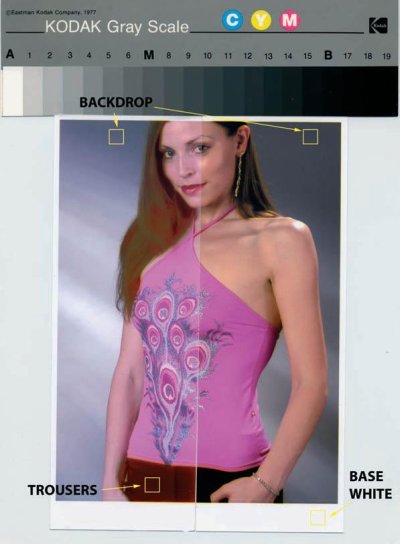articles/Digital/fadeline-page1
Fade & Line Quality Testing - part 1 of 1 2 3 4
by Mike McNamee Published 01/02/2006

Fade testing
A fade testing standard remains a contentious issue with no immediate resolution in sight. Henry Wilhelm, secretary of the relevant ISO technical committee wrote, in a recently published report, 'In several significant aspects the new ISO 18909 is viewed by this author as a further, significant, weakening of the previous, already weak, standards.' In another part, Wilhelm takes Kodak to task for claiming fade resistance for its Ultima paper using a methodology which inflates the anticipated life between 4- and 8-fold - small wonder that the consumer is confused and it seems likely that ISO 18909 is not going to clear the air. The conclusion may be drawn that the only way to maximise fade
„` Use only pigmented ink from a reputable source.
` Use only paper with a microporous coating.
` Use acid-free papers.
` Use OBA-free papers.
`Use a postproduction spray or brushed coating, if you can.
` Treat the prints with care; mount behind glass, out of direct sunshine.
Humidity Testing
This is an area where a lot more data has surfaced, not all of it welcome. We have for some time had a test-sample series waiting to be written up. Prepared by Martin Sellars, they are a horrifying collection of faded, discoloured and damaged dye ink-jet prints which have been subjected to little more than the passage of time in moderately damp conditions. Exposure was to indirect winter sunlight, behind glass, for 81 days between mid-November and early February. The prints were subjected to the humidity but half covered against light exposure, all were taped in the same window. The bleeding of the dark colours into the lighter ones - so-called lateral bleed - is as much as 1mm. We have been beaten to publication by Wilhelm Research which published in 2003 and 2005, but its data looks to be a close mimic of what we have observed. Wilhelm has spent its time devising a methodology for quantifying lateral diffusion of colourants under humid conditions, by using a simple spectrographic analysis before and after exposure to generate a Line Quality Retention value. Its data show that pigmented inks and microporous coatings are good and that dye pigments and swellable polymer coatings are very poor. The downside is that Wilhelm has also published data showing that ink fade due to the catalytic effect of ozone is worse with microporous ink than with swellable polymer! Again this points to a microporous/pigment ink solution, possibly with the addition of an applied coating to protect the finished print.

The images on this page and the table on the previous page show some of our data. In practical terms we observe that our model was wearing silver earrings when photographed but that they turned to a rich gold colour on exposure, when imaged with dye ink onto a swellable polymer substrate. In some instances, the loss of density due to light exposure amounted to between 30 and 36 Lab Delta E points. It was not all bad news though. RA14, Kodak Dye Sub (its 8500 model), Epson Ultrachrome Ink and Epson Enhanced Matte paper (a Microporous media) fared very well. Epson Dye ink was better than third-party dye ink. Testing of this type is very complex with multiple, interactive variables. However for long-term stability the message remains as listed on the opening page, except that you can drop the Kodak 8500 and RA 14 into the good mix! Epson comes out well from all this, their dye ink was better than third-party and the hybrid, pigment/dye, UltraChrome ink set fared well.
ABOVE: This is the test image used by Martin Sellars (original below). The exposed sample, shown left, exhibits gross posterisation and loss of density on the left, which was exposed to daylight, and colourant migration on the right, which was shielded from light, but under the same humidity conditions. This is a dye-ink/gloss paper combination. The enlarged segment of the test, shown below, illustrates the degradation due to lateral colourant diffusion as evidenced by the change in the colour of the earring and the bleed at the edges of the print. The areas marked out in yellow show the zones referred to in the table on the opposite page.
You are currently on page 1
- Fade & Line Quality Testing page 1
- Fade & Line Quality Testing page 2
- Fade & Line Quality Testing page 3
- Fade & Line Quality Testing page 4
1st Published 01/02/2006
last update 09/12/2022 14:54:06
More Digital Articles
There are 4 days to get ready for The Society of Photographers Convention and Trade Show at The Novotel London West, Hammersmith ...
which starts on Wednesday 14th January 2026





